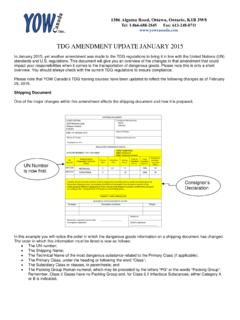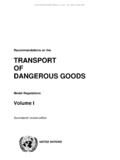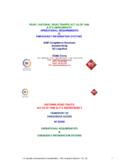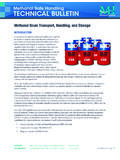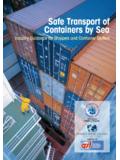Transcription of Transportation of Dangerous Goods Harmonization …
1 Transportation of Dangerous Goods Harmonization amendment Goal: In mid-July 2017 the Transportation of Dangerous Goods Regulations (TDGR) were amended to be harmonized with other global regulations. Those regulations are the United Nations (UN) recommendations (19th edition) and subsequently the ICAO as well as the IMDG Code. Finally, Canada s TDG regulations have been better integrated with the US equivalent, 49 CFR regulations. The goal was to further allow Canada to more easily trade with countries under the United Nations including the United States. Impact: While the entire Harmonization amendment (as it is dubbed) was extensive overall including a great deal of changes to Schedules 1, 2 and 3, the following outlines some of the smaller details as they relate to the TDG Regulations by road . For more extensive details on the entire amendment please view the Canada Gazette here (Page 222 for the Technical Data and Page 298 for the Regulatory Impact Analysis Statement).
2 Placarding and Labelling: For the TDG regulations by road, one of the most significant changes that applies to many customers is Placarding, Labelling and Safety Marks. New Class 9 Placard: Perhaps the simplest is the regular Class 9 placard now has the number 9 underlined in order to prevent confusion and match-up better with the United Nations Regulations. OLD NEW Fumigation Sign: The Fumigation Sign has changed with different dimensions, wording and it is no longer bilingual but allowed to be individually shown in English and/or French. Lithium Batteries: Lithium batteries are Dangerous Goods , much like gasoline, propane, and acid. In Canada, the shipping and importing of lithium batteries is subject to the Transportation of Dangerous Goods Act and its Regulations. Lithium batteries are used in many electronic devices such as cameras, cell phones, laptop computers, and power tools. When you ship or import lithium batteries, including those contained in or packed with devices and equipment, you must meet shipping requirements and declare package contents to postal carriers, couriers or transport companies.
3 Concerns: While most lithium batteries are safe, some have overheated and caught fire. Once ignited, they can cause any nearby batteries to overheat and catch fire. These fires are difficult to put out and produce toxic fumes. When shipping lithium batteries, it is not always clear which mode of transport will be used. Your shipment may end up on an aircraft, and an aircraft's fire suppression system may be unable to extinguish all types of lithium battery fires. Changes to TDG for Lithium Batteries: A new Label (not a placard) and Safety Mark has been added for Class 9 Dangerous Goods for Lithium Batteries. These are being phased-in from now until January 1, 2019 when they become mandatory. If not subject to Special Provision 34 in Schedule 1 of the TDGR, the following Label must be displayed: ( (b)(1)). If subject to Special Provision 34 in Schedule 1 of the TDGR, this Lithium Battery Handling Mark must be shown ( ) The first * is replaced by the UN Number of the batteries and the other two ** are replaced with a phone number where additional information can be obtained.
4 Workers responsible for transporting or preparing for transport lithium batteries should therefore review their internal procedures when it comes to labelling and packaging these products for transport. Overpacks: The OVERPACK or SUREMBALLAGE letters must now be at least 12 mm high on a contrasting background. However neither of these markings are required anymore if a safety mark for each class of Dangerous Goods inside the overpack is visible through the transparent overpack wrapping. See section Safety Marks in the TDG Regulations on an Overpack for more information. Hot Air Balloon Exemption : For years the cylinders used to propel hot air balloons into the air have been transported against the TDG Regulations. This is primarily because as the flammable containers of compressed and flammable gas have been transported by ground, they had to meet a certain criteria. And then, those same cylinders of compressed and flammable gas were then loaded onto a hot air balloon which thus converted the situation to a Transportation by Air situation where different TDG rules and regulations applied and vice-versa.
5 So, in a nutshell, some people were inadvertently breaking the law. Band-aid solutions were in place but were not practical over the long-term. The new rules allow for these compressed gas cylinders to be transported legally under both modes of Transportation (by road and by air) without any violations. Most cylinders under these conditions have quite stringent requirements, but for hot air balloons, cylinders of gas have an exception and can be unusually filled up to 85% of their capacity. This is not allowed for most other similar circumstances. Definitions: Some definitions in Part 1 have changed including a few new definitions such as Absorbing gas, Neutron radiation detector and Radiation detection system. Other Changes: Other small changes include the fact that the word WASTE is allowable for use before and after the SHIPPING NAME on any documentation. Although not road related, following the events that transpired in Lac-M gantic, there are further limitations on the use of jacketed and non-jacketed legacy rail tank cars for crude oil in order to prevent future catastrophic events.
6 There have also been a number of updates to CGSB standards for packaging DGs. It is recommended that you re-visit these new standards when it comes to selecting or manufacturing means of containment for Dangerous Goods . YOW Canada s TDG Online training updates: In response to the TDG updates listed above, YOW Canada completed updates to its TDG online courses on August 9th, 2017. Anybody who completed the training after that date received the updates. Sources: Transport Canada s Transportation of Dangerous Goods Regulations.
